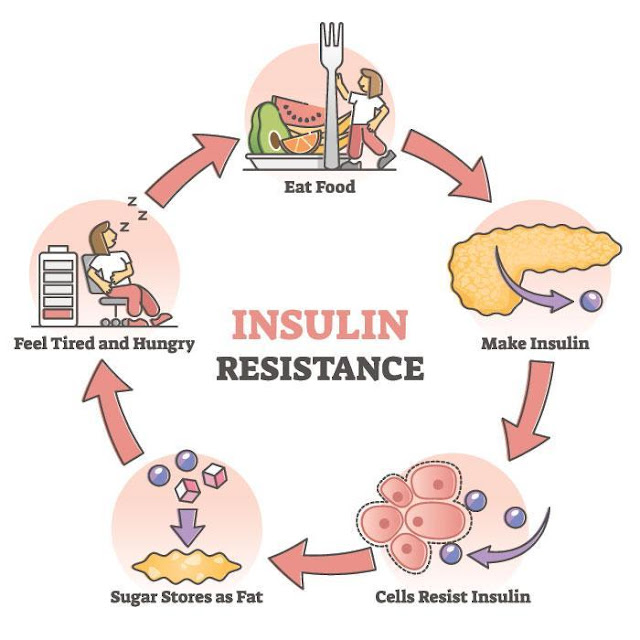Insulin Resistance: The Silent Killer That You Can Completely Reverse
Insulin resistance, i.e., the inability of the body’s cells, especially liver, muscle, and brain, to respond to insulin and allow blood sugar to enter cells, drives numerous abnormal health conditions including Type 2 diabetes, hypertension, coronary heart disease, fatty liver, Alzheimer’s dementia, and cancer. It is therefore a driving force behind so many modern and common chronic health conditions.
 |
| Credit: Breathe Well-Being |
You can recognize insulin resistance because it:
- Causes high resting blood sugars—i.e., any value above 90 mg/dl.
- Causes high resting blood insulin—i.e., any value above 3 or 4 mIU/L.
- Causes higher blood triglycerides—Any value of 60 mg/dl or higher signals increasing levels of insulin resistance.
The conventional medical response to even flagrant levels of insulin resistance? Mostly do nothing except to deal with overt consequences such as high blood sugar in the diabetic range (126 mg/dl or higher) or high triglycerides (400 mg/dl or higher). Some prescribe a class of drugs called glitazones or thiazolidinediones that modestly reduce insulin resistance but have been plagued with problems such as weight gain, massive fluid retention, and congestive heart failure.
The original drug in its class, troglitazone, was withdrawn from the market due to cases of liver damage, but pioglitazone (Actos) and rosiglitazone (Avandia) remain on the market. Rosiglitazone has also been associated with increased risk of heart attack. But that’s it: That is as far as conventional efforts go to reduce or reverse insulin resistance.
Yet there are SO many steps you can take to reverse insulin resistance and thereby reduce or eliminate risk for all those diseases —from Type 2 diabetes to dementia. This is not speculation—the evidence is overwhelming. Among the steps you can take include:
- Diet—Eliminate the foods that provoke blood sugar and thereby rises in insulin. These are carbohydrates, especially the amylopectin A of grains, fructose, and sucrose (table sugar). If you have no rise in blood sugar, there is no rise in insulin and insulin resistance and high blood insulin recede over time. Grain and sugar elimination also hugely reduces de novo lipogenesis in the liver, the liver’s conversion of carbs to triglycerides that thereby helps reduce blood triglycerides and fatty liver, further reversing insulin resistance.
- Vitamin D—Restoration of vitamin D to healthy levels (we aim for 60-70 ng/ml) reduces insulin resistance.
- EPA and DHA—The omega-3 fatty acids, EPA and DHA, reduce the postprandial (after-meal) rise in VLDL [very-low-density lipoprotein] particles that derive from liver de novo lipogenesis. This adds further to reducing insulin resistance.
- Magnesium—Magnesium deficiency, widespread and severe due to reliance on filtered drinking water and reduced magnesium levels in vegetables, amplifies insulin resistance—restoration helps reverse it.
- Iodine and thyroid optimization—The worse the level of hypothyroidism (signaled by rising levels of TSH [thyroid stimulating hormone]), the worse the insulin resistance, even at low levels in the “normal” range. Supplementing iodine corrects mild hypothyroidism in about 20 percent of people. Others will need to explore thyroid status further. Uncorrected hypothyroidism can also, via reduced intestinal motility, commonly encourage SIBO [small intestinal bacterial overgrowth]that further worsens insulin resistance.
- Efforts to correct dysbiosis/SIBO—The metabolic endotoxemia of dysbiosis and SIBO, i.e., the flood of inflammatory factors from dying bacteria such as E. coli and Enterobacter, is a huge factor amplifying insulin resistance. Correcting these situations reduces metabolic endotoxemia and thereby insulin resistance.
These strategies also enjoy a powerful synergy. Correcting iodine deficiency/hypothyroidism, for example, helps reduce visceral fat and metabolic endotoxemia. I call the powerful synergy that emerges from these efforts the “2 + 2 = 11” effect.
Do these strategies look familiar to you? They should, because they are the six basic strategic components of the Wheat Belly and Undoctored programs. This is a big part of the reason why these programs are so spectacularly effective in reducing blood sugar, reducing blood pressure, reducing triglycerides, reversing fatty liver, and reducing or reversing insulin resistance.
The list of strategies in my programs is not a random hodgepodge of nutritional supplements—they were carefully and thoughtfully picked and crafted to achieve specific effects, addressing nutrient deficiencies or, in the case of the microbiome, addressing disruptions that are painfully common in modern life. And you can appreciate that we go way beyond diet to achieve these benefits—diet alone is powerful, but not enough.
Republished from DrDavisInfiniteHealth.com
Related: I-CARE Insulin Resistance Protocol (FLCCC)






.png)

Comments
Post a Comment